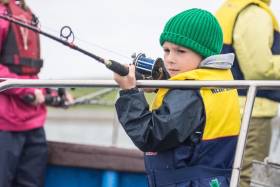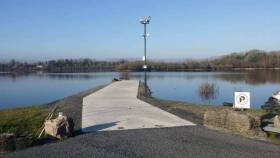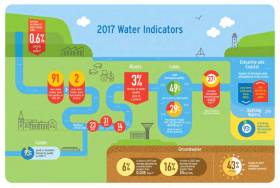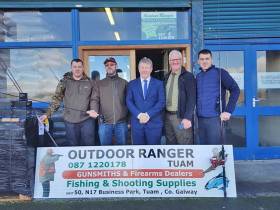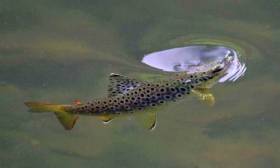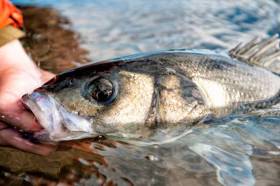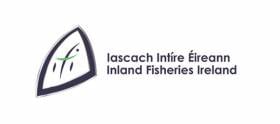Displaying items by tag: Inland Fisheries Ireland
Funding Available For Angling Projects & Events In 2019
#Angling - Inland Fisheries Ireland (IFI) has launched its Sponsorship Programme for 2019 and is now inviting applications from suitable angling events and initiatives nationwide.
The programme, which is one of the funding mechanisms of the National Strategy for Angling Development, awarded funding to 62 Irish angling events and 10 teams representing Ireland in overseas international events to the combined value of €30,000 last year.
Sean Canney, Minister of State with responsibility for the inland fisheries sector, said: “I want to congratulate Inland Fisheries Ireland for making financial support available once again in 2019 for projects and events which will support novice and junior anglers and help grow angling tourism.
“I support Inland Fisheries Ireland’s aim to help ‘bring angling to the people’ by supporting initiatives which help remove barriers to those looking to try fishing or for younger people who already enjoy the pursuit. IFI is working to support events and initiatives which promote the angling tourism product with a view to growing angler tourist numbers and economic return.”
The Sponsorship Programme supported 17 initiatives by local angling clubs during the year which included junior competitions, summer leagues, disability outreach programmes and angling coaching workshops.
In total, 630 juvenile and novice anglers participated in these initiatives and almost 300 of them joined a fishing club for the first time following their participation in a local engagement project.
In addition to junior and novice angling projects, there were 28 large scale angling events supported via the programme in 2018 with 1,866 experienced anglers taking part. Over 800 anglers travelled from outside Ireland to participate in these angling competitions, IFI says.
The events and initiatives which are eligible for funding in 2019 include:
- Large international competitions held in Ireland which showcase Ireland’s angling and contribute to local economies, supporting jobs and businesses.
- Novice angler events and training courses which increase participation in angling including funding of transport hire for participants to facilitate attendance at novice angler events.
- Initiatives to promote fisheries awareness and/or conservation and protection of the inland fisheries and sea angling resource.
- Initiatives promoting angling as a key Irish tourism activity, such as via high quality angling promotional videos, seminars, coaching, training, workshops, etc.
- Juvenile and minority angling teams representing Ireland at international events both home and abroad.
“Our 2019 Sponsorship Programme will play an important role in driving angling participation among novice and junior anglers,” said Suzanne Campion, head of business development at IFI. “The Sponsorship Programme has awarded €30,000 per year over the past five years to angling clubs and groups nationwide to help in the delivery of local angling events.
“In addition to supporting those who are casting for the first time, we also have a unique opportunity to grow our angling tourism product. The Sponsorship Scheme offers clubs and associations an incentive to engage overseas anglers to visit our renowned wild fisheries and to enjoy fishing here in a conservation focused manner.”
Applications for funding from the Sponsorship Scheme are now invited from angling clubs, associations or any local group organising an angling initiative.
The scheme will remain open for funding applications until Friday 18 January with applications for equipment, staff support and biosecurity assistance available throughout the year. Awards will be subject to budget availability and adherence to the scheme requirements.
To find out more and to apply, see the Sponsorship Programme page on the IFI website.
Improvement Works Completed At Popular Co Mayo Angling Destination
#Angling - Ballinrobe & District Anglers have successfully completed a project which will greatly improve access to a popular angling destination at Cushlough Bay in Co Mayo.
The project was funded by Inland Fisheries Ireland (IFI) via the National Strategy for Angling Development (NSAD) Fund. The location at Cushlough Bay, off Lough Mask near Ballinrobe is used by domestic and visiting international anglers alike.
The project saw improvement works completed on the angling club’s carpark to make it safe and accessible for anglers. This included resurfacing and realigning of the carpark, as well as the provision of security fencing around the perimeter.
The club was awarded €21,263 from IFI to carry out the work. The funding was granted in June, after the club completed its corporate governance requirements, with the project at completion stage just a few weeks later.
IFI granted support under its National Strategy for Angling Development (NSAD) which aims to ensure that Ireland’s fish stocks and angling infrastructure are protected and enhanced for the economic value and recreational benefit which they offer to communities across Ireland.
The fisheries resource is worth €836 million to the Irish economy annually and supports upwards of 11,000 jobs, often in rural and peripheral communities.
In addition to the funding provided under the NSAD, Ballinrobe & District Anglers and the World Cup Trout Fly Championship Committee provided €6,641 to upgrade the slipway as an extra part of the project.
Sean Canney TD, Minister of State with responsibility for the inland fisheries sector, said: “Investment in angling access and infrastructure is a key component of the current round of NSAD funding and the Ballinrobe club has demonstrated that, working in partnership with Inland Fisheries Ireland and underpinned by significant grant aid, valuable community driven projects will be delivered.
“The project will be of major benefit to local, visiting and international anglers and will define Cushlough Bay as a top class venue for social and competitive angling and can assist in attracting international events.”
Suzanne Campion, head of business development at IFI, added: “Accessibility and safety is a priority if our inland fisheries are to be enjoyed by everyone. I am delighted that this project is complete in Ballinrobe at an important angling location which has both recreational and socio economic benefit to the local community.”
Kevin Egan, chair of Ballinrobe & District Anglers, commented: “This is an outstanding project which we are delighted to complete. The funding from the National Strategy for Angling Development allowed us to upgrade the parking facility which will be of benefit for local anglers and tourist anglers.”
Historic Low In Fish Kills Welcomed - But Water Quality Concerns Remain
Inland Fisheries Ireland (IFI) has noted with caution the findings from the Environmental Protection Agency’s (EPA) report on water quality in 2017.
While it welcomes the fact that the number of fish kills in Irish waters were at a historic low last year, IFI is calling for continued awareness of water quality issues in light of the EPA’s conclusion that water quality is once again in decline.
According to this latest report, there was 14 fish kills in 2017, affecting 7.8km of river with 2,123 dead fish recovered. This is significantly lower than the worst years of 1987 and 1989 when there were more than 100 fish kills reported.
IFI’s Environmental Officers carried out 26,000 environmental inspections last year across agricultural sites, habitats, industrial sites, wastewater and water treatment plants, civil engineering sites and forestry sites.
Despite the positive drop in serious pollution events causing fish mortalities, IFI remains concerned about the reduction of water quality, with the EPA reporting a 3% drop in river water quality since 2016 and a 0.6% loss in high-quality river sites.
The inland fisheries and sea angling resource contributes €836 million to the Irish economy every year and supports 11,000 jobs in rural communities.
“Ireland has some of the best wild fisheries in Europe and while water quality in Ireland still compares favourably with our European neighbours. The current decline is a source of concern as any impact on the quality of our waters can have a negative impact on the freshwater fisheries resource,” said IFI chief executive Dr Ciaran Byrne.
“Not only is the quality of our natural environment and aquatic habitat inextricably linked to the appeal of Ireland as an angling and holiday destination, it is also a very important source of wellbeing for our people.
“It is essential that we protect and conserve our freshwater assets, meaning our rivers and lakes. The long-term conservation of the resource requires maintenance of healthy and ecologically viable ecosystems.
“That means that we need to prioritise monitoring and protecting water quality as well as dealing with other issues such as removing fish migration barriers, improving practices which cause physical changes to fisheries habitat, dealing with changes in water quantity and controlling the spread of invasive species,” Dr Byrne added.
New Angling Outreach Initiative Reels In Novices In Galway
#Angling - The Outdoor Ranger Tuam Angling Education Programme provides information sessions, skills workshops and fishing excursions to young people who may be interested in trying out the pursuit.
Sean Canney TD, Minister of State with responsibility for inland fisheries, expressed his full support for the Tuam-based programme this week and welcomed the funding from Inland Fisheries Ireland’s National Strategy for Angling Development Fund to support its rollout.
“This programme will encourage and engage young people in angling and allow experienced volunteer anglers from local clubs to pass on their knowledge and skills to the next generation,” Minister Canney said.
“Collaboration such as this is vital to ensure that these skills, developed over many years, are not lost. I am particularly pleased that the Outdoor Ranger Tuam Angling Education Programme is supported locally by Cairde an Chláir working with Inland Fisheries Ireland.”
The programme commenced in October with a strong uptake, and participants enjoyed guest appearances from well-known anglers during the programme.
Nathan Creaven from Kilconly, Tuam who fly-fished for Ireland earlier this year, demonstrated his fly-tying skill, while Owen Trill, and international fly-tier from Galway, gave his own demonstration at one of the skills workshops.
The information sessions and workshops aimed to provide students with the basic skills necessary for recreational angling. Young people took several lessons on several topics including sustaining quality habitats, line rigging, baiting, knot-tying, casting techniques, fish retrieval, fish handling, catch and release, rules and regulations of angling and biosecurity.
In addition, they enjoyed a fishing trip to Oughterard Fishing School where they had the opportunity to put their new found angling skills to practise.
The programme received funding from IFI’s National Strategy for Angling Development Fund. The strategy aims to ensure that Ireland’s angling resource is protected and conserved in an environmentally sustainable manner for future generations to enjoy while also striving to make angling an accessible and attractive pursuit for all.
Suzanne Campion, Head of Business Development at Inland Fisheries Ireland said: “We are delighted to support the Outdoor Ranger Tuam Angling Education Project through our National Strategy for Angling Development.
“It is through partnerships such as this one [in Tuam], where local fishing clubs and associations are working together in a constructive and positive manner, that we will secure the future of our fisheries resource,” said Suzanne Campion, IFI’s head of business development.
Teresa Kelly from the Outdoor Ranger shop in Tuam added: “Learning to become an angler is something we took for granted when we were young. We took our bike out and headed off to the river for the day. But this is a thing of the past and the amount of young people that don’t know anything about angling, or that it’s even a sport, is shocking — especially as we have the finest rivers and lakes at our doorstep.
“This is the issue that the Outdoor Ranger Tuam Angling Education programme wants to highlight and also to make changes by providing information and day trips out fishing with young people to give them to the opportunity to learn and gain a love of angling.”
In other news, applications are open till 5pm this evening (Friday 30 November) for the Support Scheme for Former Eel Fisherpersons.
The fund offers a restitution payment specifically targeted at former licensed eel fisherpersons who were actively engaged with the commercial eel fishery prior to the National Eel Management Plans and the 2008 public consultation which subsequently lead to the closure of the commercial eel fishery.
Details on the scheme are available on the IFI website. Late applications will not be accepted.
Minister Welcomes Inland Fisheries Ireland Funding For ‘Fishing Futures’ Project In Wicklow
#Angling - Fishing Futures, a project targeting local community groups in Wicklow, has been awarded funding from Inland Fisheries Ireland to help support its work.
The project, which is organised by the Wicklow Travellers Group, allows young people to experience angling in a safe and supervised environment.
Sean Canney TD, Minister with responsibility for the inland fisheries sector, has welcomed the initiative and the funding by IFI of €1,630 through the National Strategy for Angling Development.
“This investment will support the purchase of new fishing equipment enabling larger groups to engage in angling trips and increase participation across the community,” said Minister Canney.
“Over the coming year, local volunteer anglers and an outreach worker working with Wicklow Travellers Group will provide access to young people to organised angling activities as an enjoyable and rewarding component of healthy outdoor pursuits.”
Participants in the project will learn about water safety, bait collection and preservation, healthy lifestyle as well as practical angling skills.
The project ultimately aims to provide novice anglers with the necessary skills to engage in mainstream angling with local clubs.
Since the inception of the project over 11 years ago, it has engaged with many groups from the community. Some of the volunteer anglers who support the project today took part in the initiative themselves over a decade ago.
Letterkenny School Nets Top Prize In 2018 ‘Something Fishy’ Competition
Letterkenny Educate Together National School has been named winner of the national education programme Something Fishy for 2019.
The students from fifth class were presented with the Something Fishy perpetual trophy and a monetary prize by Minister for Education Joe McCue at their school yesterday (Monday 19 November).
The pupils received the national accolade for their project called Save Our Schools (SOS), which saw the class build a website aimed at engaging other children and young people to learn about fish and the importance of protecting the fisheries resource for angling and inland fishing.
The webpage included digital games and video content, all devised and produced by the children themselves.
During the 2017-2018 academic year, 99 national schools and 10 education centres took part in the Something Fishy programme, reaching some 3,000 students.
The Something Fishy education programme is an initiative of Inland Fisheries Ireland, in partnership with Blackrock Education Centre, which allows students to learn about fish and the environment in a local context.
Students enjoy classroom-based activities as well as practical field trips with fisheries officers as part of the programme, which is promoted and delivered by education centres nationwide. In addition, students compile and submit projects on their learning for assessment by an independent judging panel.
Teachers and students participating in the Something Fishy programme explore eight different lessons on the fisheries resource, after which they receive a visit from inland fisheries Oofficers who introduce them to their local river and the fish and invertebrates who live within in. Since its inception in 2005, over 50,000 students have participated in the programme.
Minister McHugh said: “This year’s award is particularly special as we embark, in conjunction with countries all over the world, on the International Year of the Salmon to celebrate the shared cultural and mythological place of salmon in societies around the globe.
He added: “I am particularly proud that Donegal, and especially the Letterkenny area, has built up an excellent pedigree in this competition with this year’s champions following in the footsteps of Gartan NS who won the title last year.”
Inland Fisheries Ireland chief executive Dr Ciaran Byrne said: “Letterkenny Educate Together really impressed the judging panel with their use of digital communications to highlight significant conservation messages for their peers. I would like to congratulate the children and their teachers, Nakita Burke and Cliona Marley, for showcasing important learnings about the local fisheries environment in such an effective manner.”
Jacqui Dillon, director of Donegal Education Centre, said the county’s second win in two years “is reflective of the commitment of the teachers involved and the keen interest they have engendered in their pupils”.
New Protections For Wild Brown Trout As Designated Salmonid Waters Bye-law Comes Into Operation
#Angling - The Designated Salmonid Waters Bye-law was yesterday (Thursday 25 October) signed by the Minister for Communications, Climate Action and Environment, Richard Bruton.
The overall intention behind the bye-law is to afford additional protection to wild brown trout in seven distinctive State–owned waters where established stock control measures are already in place as a matter of existing policy.
The seven waters are Lough Sheelin in the Limerick Fishery District; Loughs Conn and Cullin the Ballina Fishery District; Loughs Corrib, Mask and Carra in the Galway Fishery District; and Lough Arrow in the Sligo Fishery District.
Sean Canney, who is succeeding Sean Kyne as Minister of State with responsibility for the inland fisheries sector, welcomed the bye-law as an important initiative for brown trout fisheries particularly in the West of Ireland.
“My predecessor Seán Kyne gave notice of his proposals to make the bye-law and also instigated a public consultation during which observations and views expressed across the full range of stakeholders,” said Minister Canney.
“I am happy as incoming minister to support Minister Kyne’s long-standing initiative and his hard work over all of 2018 in bringing the bye-law to fruition.”
Minister Kyne said: “As minister with responsibility for inland fisheries, I had carefully considered the submissions made in the public consultation.
“The bye-law relates to seven limestone lakes which are quite unique in terms of topography and trout habitat and have long been managed as wild brown trout fisheries via established stock management programmes. From that perspective, I considered that these waters are especially important.
“The bye-law was just about complete when I was taking on my new role and I am grateful for the support of Ministers Bruton and Canney for bringing it over the line,” he added.
The bye-law gives statutory status to the policy designation of this small number of distinctive waters and means that the waters concerned will continue to be managed primarily as brown trout waters.
Minister Kyne had indicated his view that the importance of these waters should be reflected by way of statutory designation and commenced that process in the department.
The bye-law also includes the prohibition on the introduction of fish to the designated waters which is consistent with the overall policy thrust of Inland Fisheries Ireland to manage these waters primarily as brown trout waters.
The advantages of this measure include addressing biosecurity and genetic concerns, control and management of the potential transfer of pathogens, and safeguarding against the introduction of alien invasive fish species.
The announcement came as Bord Iascaigh Mhara is hosting a two-day conference on the scientific developments within the salmon farming industry in Galway’s Maldron Hotel on 25-26 of October.
Outlining the purpose of the event, BIM’s Geoffrey Robinson said: “With increasing global demand for fish, aquaculture is now the fastest-growing animal food production sector in the world. Consequently, fish farming operations are rapidly evolving with new technologies and equipment constantly being developed.
“Part of BIM’s work is to help fish farmers to keep their operations at the cutting edge of technology and an event like this allows us to showcase the latest innovations to Irish operators. There will be a number of interesting developments discussed not least the growing use of cleaner fish and desalination systems.”
Twenty-five separate presentations from national and international experts will cover the latest research and technological developments within the sector on issues such as fish health and welfare, structural and service equipment as well as organic certification.
“While production volumes in Ireland are small by international standards, we have a reputation for excellence in organic salmon production and it is important that our operations maintain this high standard. Incorporating leading edge technologies can improve our production efficiencies and strengthen our sustainable practices,” Mr Robinson added.
In 2017 Irish salmon production increased 15.6% to 19,305 tonnes, with a value of €141.2 million. The industry employs 210 people, primarily in production sites along the west coast of Ireland. Irish salmon is exported to diverse markets across the EU, North America and the Near and Far East.
Anglers Will Be Allowed One Bass A Day From Monday
#Angling - Anglers fishing in Ireland will now be allowed to keep one bass a day from Monday 1 October till the end of 2018.
The move follows new advice from the International Council for the Exploration of the Sea (ICES) that affects all divisions around the island of Ireland.
According to this advice, recreational angling does not impact on bass stocks to the degree previously believed.
ICES also estimates a 10% higher survival rate from catch-and-release angling than previous figures.
Inland Fisheries Ireland (IFI) reminds bass anglers that a minimum size limit of 42cm still applies.
“Bass anglers have an extremely positive approach to bass conservation using catch and release alongside good handling in order to maintain the species and their recreational activity,” IFI says.
“Anglers, through their conservation-oriented ethos, have been the key stakeholders in supporting research into bass stock status over the past five years by providing catch and fish stock data, which has underpinned provision of scientific and management advice.”
Fish Kill Confirmed On 5km Stretch Of Dublin’s River Tolka
#Angling - Inland Fisheries Ireland (IFI) has confirmed a fish kill on the River Tolka that was reported earlier this week.
Fisheries investigators found dead fish over a 5km stretch of the river in the Tolka Valley Park area, following the report on Tuesday 18 September.
According to IFI, a “significant source of polluting material has been identified” and samples were taken for analysis.
In the meantime “relevant parties are undertaking appropriate remedial action” as the investigation continues.
Also this week, Minister of State for inland fisheries Seán Kyne committed €300,000 for the removal of an invasive waterweed in Lough Corrib.
IFI will begin operations in 2019 to remove the aquatic plant Lagarosiphon major from the lough, after successful cutting and picking operations over the summer months this year.
In addition to these management operations, IFI commenced a research project last month which aims to establish the current distribution of L major in Lough Corrib.
New innovative methods are being trialled to survey the aquatic plant as part of this research. These include unmanned aerial drones, sub-aquatic remotely operated vehicles (ROVs) and modern remote sensing techniques.
Speaking as he visited IFI’s stand at the National Ploughing Championships, Minister Kyne also asked the fisheries body and his department to continue liaison with the National Parks and Wildlife Service (NPWS), who have responsibility for the legislation covering Alien Invasive Species (AIS).
Try Out Angling At The National Ploughing Championships This Week
#Angling - Novice anglers are invited to try their hand at fishing at the upcoming National Ploughing Championships.
Inland Fisheries Ireland will attend the three days that kick off in Screggan near Tullamore, Co Offaly from tomorrow, Tuesday 18 September, with a fun fishing simulator suitable for all the family.
The simulator will be present at IFI stand within the Department of Communications, Climate Action and the Environment’s tent at the championships.
Fisheries officers will be on hand to answer questions from members of the public around best farming practice on waterways, and how to take up angling as a novice, as well to provide information and guidance around Ireland’s fish species and the aquatic environment.
There will also be aquariums with a range of coarse and game fish species on display.
“The participation of the public in the fisheries resource is vital in ensuring it is protected and enhanced in a sustainable manner for both the recreational and economic benefits it offers to communities nationwide,” says Suzanne Campion, IFI’s head of business development.
“We are looking forward to sharing insights into the fisheries resource, and the indigenous fish species that live within it, with both the general public and the farming community.”
Also exhibiting at the National Ploughing Championships this year are Leave No Trace Ireland and the Marine Institute’s Explorers Education Programme, who aim to highlight the impact of plastics in our oceans at their stand in the the Department of Community and Rural Affairs tent.
“A truckload of plastic waste finds its way into the ocean every minute of every day, and it is estimated that by 2050 there could be more plastic by weight than fish in the ocean unless behaviours change,” explains Maura Lyons, chief executive of Leave No Trace Ireland.
“Although we are all contributing to this worldwide epidemic, recent campaigns such as Say #No to Plastic have generated an amazing amount of supporters at community levels – particularly with children and families wanting to create change.”
With the research being completed in Ireland and around the world, results of plastics making their way into the ocean are showing a significant impact on the marine environment and animals.
Unprecedented levels of microscopic plastic particles were recently detected in an oceanic survey carried out by phytoplankton, biotoxin and oceanographic scientists from the Marine Institute.
From the larger plastics to clothes fibres from our washing machines all making their way into the ocean, visitors to the Leave No Trace/Explorers Education stand will get an opportunity to learn how long it takes for single-use plastic to break down, as well as receiving tips on how to go plastic free.
Those attending will also get to see live native marine species that are typically found in rock pools around the Irish coast including dogfish, plaice and starfish in the Explorers display boat.
“It is great to see an increased interest from children, schools, communities and businesses in Ireland that have already committed to reducing single-use plastics by offering alternatives for customers,” Lyons says. “These small changes can result in big impacts, which will help encourage a change in behaviours.”




























